
Henry S. Thompson was an American songwriter of the mid-nineteenth century.

Horticultural Hall, at the corner of Huntington Avenue and Massachusetts Avenue in Boston, was built in 1901. It sits across the street from Symphony Hall. Since 2020, it has been owned by Northeastern University. It is the current home to The William Morris Hunt Memorial Library of the Museum of Fine Arts as well as to offices of Boston magazine, 829 Studios, and Small Army, in addition to a performance space of the New England Conservatory of Music.
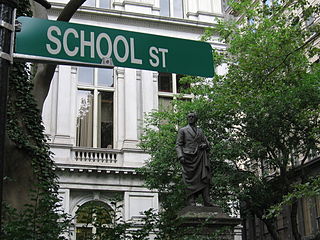
School Street is a short but significant street in the center of Boston, Massachusetts. It is so named for being the site of the first public school in the United States. The school operated at various addresses on the street from 1704 to 1844.

The Hollis Street Church in Boston, Massachusetts, was a Congregational and Unitarian church. It merged with the South Congregational Society of Boston in 1887.

The Melodeon was a concert hall and performance space in 19th-century Boston, Massachusetts, located on Washington Street, near West Street. Musical concerts, lectures, sermons, conferences, visual displays, and popular entertainments occurred there.

The Massachusetts Charitable Mechanic Association (est.1795) of Boston, Massachusetts, was "formed for the sole purposes of promoting the mechanic arts and extending the practice of benevolence." Founders included Paul Revere, Jonathan Hunnewell, and Benjamin Russell. Through much of the 19th century, the association organized conferences and exhibitions devoted to innovation in the mechanical arts.
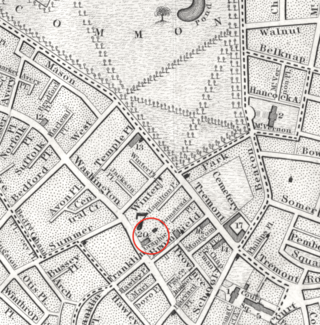
The Chinese Museum (1845–1847) in Boston, Massachusetts, showed to the public some 41 cases displaying approximately 800 objects related to Chinese fine arts, agriculture, costume, and other customs. It was located on Washington Street in the Marlboro Chapel.
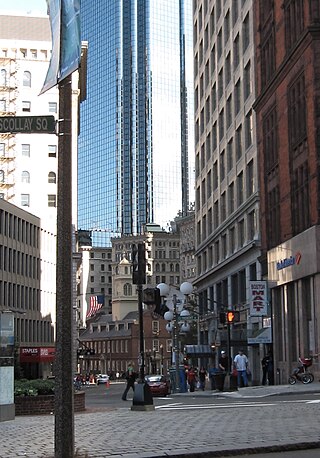
Court Street is located in the Financial District of Boston, Massachusetts. Prior to 1788, it was called Prison Lane (1634–1708) and then Queen Street (1708–1788). In the 19th century it extended beyond its current length, to Bowdoin Square. In the 1960s most of Court Street was demolished to make way for the construction of Government Center. The remaining street extends a few blocks, near the Old State House on State Street.

Merchants Row in Boston, Massachusetts is a short street extending from State Street to Faneuil Hall Square in the Financial District. Since the 17th century it has been a place of commercial activity. It sits close to Long Wharf and Dock Square, hubs of shipping and trade through the 19th century. Portions of the street were formerly known as Swing-Bridge Lane, Fish Lane, and Roebuck Passage.
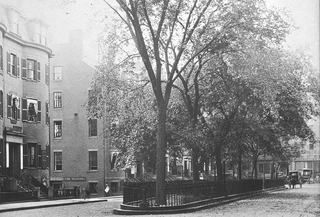
Pemberton Square in the Government Center area of Boston, Massachusetts, was developed by P.T. Jackson in the 1830s as an architecturally uniform mixed-use enclave surrounding a small park. In the mid-19th century both private residences and businesses dwelt there. The construction in 1885 of the massive John Adams Courthouse changed the scale and character of the square, as did the Center Plaza building in the 1960s.
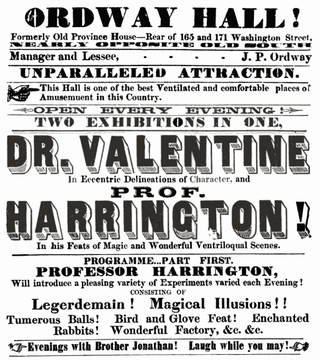
Ordway Hall (est.1852) was a theatre in Boston, Massachusetts located off Washington Street in the former Province House. John P. Ordway established and managed the hall, which specialized in "negro minstrelsy," particularly the Ordway Aeolians, his own troupe.

Cornhill was a street in Boston, Massachusetts, in the 18th, 19th and 20th centuries, located on the site of the current City Hall Plaza in Government Center. It was named in 1829; previously it was known as Market Street (1807–1828). In its time, it comprised a busy part of the city near Brattle Street, Court Street and Scollay Square. In the 19th century, it was the home of many bookstores and publishing companies. As of 1969, Cornhill exists as 144 feet along the edge of City Hall Plaza.
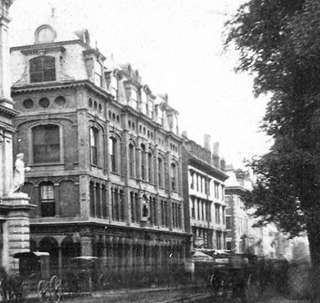
The Studio Building (1861–1906) on Tremont Street in Boston, Massachusetts, housed artists' studios, theater companies and other businesses in the 19th century. It "held the true Bohemia of Boston, where artists and literati delighted to gather." Among the tenants were portraitist E.T. Billings, architect George Snell, sculptor Martin Milmore, artists William Morris Hunt, William Rimmer, Edward Mitchell Bannister, Phoebe Jenks; gallerist Seth Morton Vose, and many others.
This is a timeline of the history of the city of Gloucester, Massachusetts, USA.

Chickering Hall (1901–1912) was an auditorium in Boston, Massachusetts, located on Huntington Avenue in the Back Bay. It stood adjacent to Horticultural Hall. Tenants included the Emerson College of Oratory and D.M. Shooshan's "Ladies' and Gents' Cafe." In 1912 it became the St. James Theatre, and later the Uptown Theatre. The building existed until 1963, when it was demolished.
Theatre Comique (1865–1869) of Boston, Massachusetts, was located at no. 240 Washington Street. Personnel included Jason Wentworth, William H. Crisp, James S. Maffitt, George Maffitt, B.F. Lowell, Wm. H. Daly, orchestra leader Aug. Muller, and maitre de ballet Signor Constantine. Among the performances: slack rope and acrobatics by Martini Chiriski and the Levantine Brothers; Mlle. Augusta, danseuse; "Aladdin" with Kate Pennoyer and W.H. Bartholomew; dancing by Betty Regl; Snow Brothers ; Morlacchi Ballet Troupe; Wilson Brothers ; Ada Harland; and Jarrett & Palmer's "Forty Thieves." It occupied the building formerly known as Andrews Hall, Barnum's Aquarial Gardens, and the Boston Aquarial and Zoological Gardens. In 1869 the theatre was renamed the "Adelphi Theatre."
The St. James Theatre (1912–1929) of Boston, Massachusetts, was a playhouse and cinema in the Back Bay in the 1910s and 1920s. It occupied the former Chickering Hall on Huntington Avenue near Massachusetts Avenue, adjacent to Horticultural Hall. For some years Loew's theatre chain oversaw the St. James. In 1929 the theatre "became part of the Publix (Paramount) chain, and was renamed the Uptown."

Horticultural Hall (1865–1901) of Boston, Massachusetts, was the headquarters of the Massachusetts Horticultural Society in the later 19th century. It stood at no.100-102 Tremont Street, at the corner of Bromfield Street, opposite the Granary Burying Ground. Architects Gridley J.F. Bryant and Arthur Gilman designed the building. Sculptor Martin Milmore created horticulturally-themed statuary for the building's exterior: "three ancient Roman goddesses ... Ceres, goddess of agriculture; Flora, goddess of flowers; and Pomona, goddess of fruit trees." In the 1880s: "the ground floor [was] occupied by stores; the second story by the Library Room of the society and a hall for the weekly exhibitions; and the upper story by a large and elegant hall used ... at the annual and other important exhibitions. Both of these halls [were] often used for concerts and the better class of entertainments. The society's library, comprising over 4,000 volumes, [was] the most valuable collection of horticultural works in the United States. The halls [were] adorned with portraits and busts of the presidents, founders, and benefactors of the society."

The Boston Evening Traveller (1845–1967) was a newspaper published in Boston, Massachusetts. It was a daily newspaper, with weekly and semi-weekly editions under a variety of Traveller titles. It was absorbed by the Boston Herald in 1912, and ceased publication in 1967.
The following is a timeline of the history of Lowell, Massachusetts, US.
















